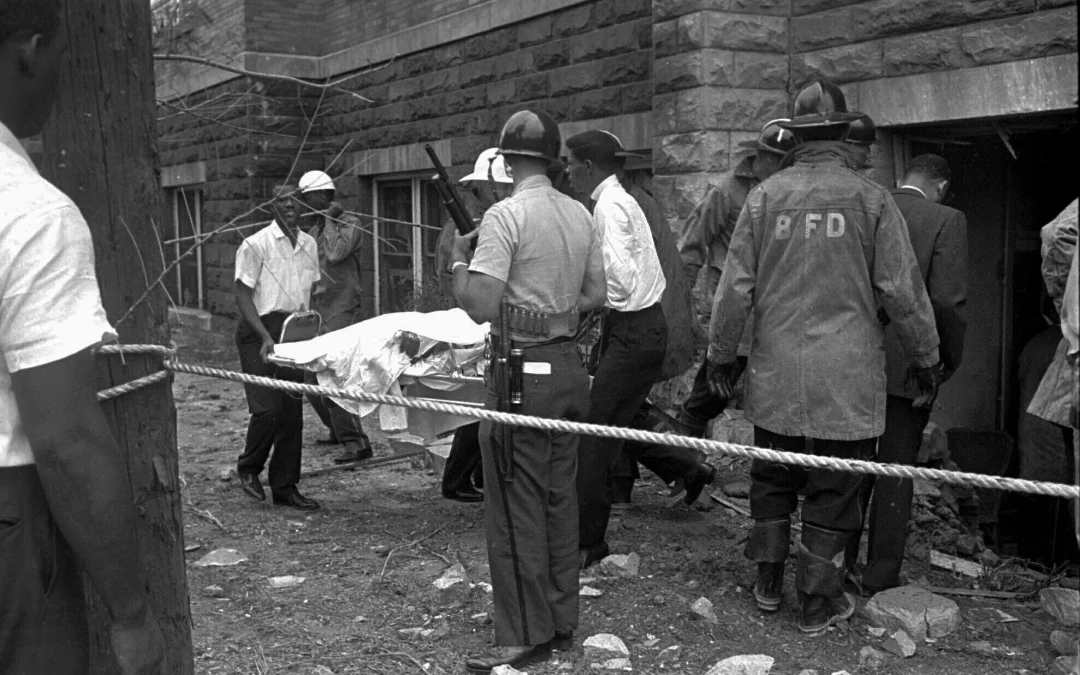
by Barnett Wright | Sep 21, 2022 | Black History, Commentary, Headline News, Social Justice |
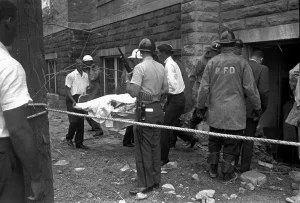
BIRMINGHAM, Ala. (AP) — When an initially blinded, and nearly lifeless, 12-year-old girl found in the rubble of a church bombing was wheeled onto the 10th floor of University Hospital in Birmingham nearly 60 years ago, one of the first people to tend to the child was Rosetta “Rose” Hughes, a nurse.
It was Hughes who stayed with Sarah Collins, the “fifth little girl” in the bombing, until a doctor arrived on that momentous Sunday, as an unforgettable chapter was being etched into the city’s history.
Hughes was on duty on Sept. 15, 1963, when a bomb demolished the 16th Street Baptist Church, killing Addie Mae Collins, 14; Denise McNair, 11; Carole Rosamond Robertson, 14; and Cynthia Wesley, 14 and injuring dozens of parishioners.
One of the surviving girls was Sarah Collins, sister of Addie Mae. On that Sunday, staff at the emergency clinic at University Hospital received the bodies of the four children killed and tended to scores of others who were injured. Sarah Collins was among the wounded, and one of the first to see her was Hughes.
“When I saw her that Sunday, … she was just covered with soot and ashes (and blood),” Hughes recalled in an exclusive interview with The Birmingham Times. “(It) looked like she was gone. … I thought she wasn’t going to wake up. … She was not moving.”
That was 59 years ago.
On Thursday, Birmingham commemorated the explosion that proved to be a turning point in the Civil Rights Movement, became a catalyst for change in the United States, and ultimately prompted global efforts for equality and human rights.
Hughes, who turns 101 in October and still lives in Birmingham, is believed to be one of the last remaining workers on duty at the hospital the day of the bombing.
Last month, for the first time since the bombing, Hughes and Rudolph, now 71, reunited for their first one-on-one, lengthy discussion of the events on that pivotal day in world history.
“It’s more than a blessing to meet her because she took care of me,” Rudolph said during the interview. “When I was younger, I didn’t know how she looked or anything because I was practically blind then. So, just to see her now and know her is a blessing. She’s looking real good.
Hughes recalled working on the 10th floor of University Hospital, which was known as the “Eye” floor, when young Sarah was wheeled in.
“I remember they brought her to the emergency room, and I was working on the Eye floor. We had the surgery up there, and they sent her to eye surgery. … She was on a stretcher, and I took care of her until they called the doctor to come in,” said Hughes, who recalls the doctor’s name only as “Pearson” and that he arrived with a toddler.
Medical staff from across the city were being called in to help with the influx of patients. Many of the doctors were scheduled to be off that weekend, and that likely included Dr. Pearson, who came to the hospital with his son. While Hughes could not remember the doctor’s first name, University of Alabama at Birmingham records show a “Dr. Robert S. Pearson” as a resident in ophthalmology at the facility in the early 1960s.
“It was a Sunday morning, and the doctor’s wife had gone to church, so he was watching the baby and had to bring him (to the hospital). … I babysat while (Dr. Pearson) checked on Sarah,” Hughes recalled.
“(Dr. Pearson) came back out and sent her back downstairs to the where she was examined at first. … They took her back on a stretcher. She was still asleep … and I didn’t have to do anything. I just had to watch her. She was also covered with ashes and smoke.”
Even though she was 12 at the time of the bombing, Collins-Rudolph, still has vivid memories of what happened.
“That’s one day I will never forget,” she said. “I remember, you know, when they operated on my eyes. … I remember when they took the glass out of my eyes, glass from my face. … The doctor had told me there were about 20 to 26 pieces of glass in my face altogether.
“I know when the doctor operated on my eyes, they put this bandage on it. … Maybe about a week later, they took the bandage off. At first, the doctor asked me, ‘What do you see out of your left eye?’ I told him, ‘I just see a little light.’ He asked me the same question (about my right eye). I said, ‘I can’t see anything.’ So, he said I was blinded instantly in my right eye.
“When (the doctor) was talking to my mother, I remember hearing him tell her that eventually I would start seeing out of my left eye because I was real young and the sight would start coming back. When I was getting ready to leave the hospital, I remember (the doctor) telling (my mother) to bring me back in February because they were going to have to remove my right eye, and that’s what they did. I went back in February, and that’s when they removed my right eye and fit me with a prosthetic.”
Sarah has had problems with her eyesight for the past 59 years. She developed glaucoma in her left eye and was initially given drops for the eye.
“That didn’t work too good, and they tried another drop. It didn’t work too good either, so they tried a third drop,” she recalled. “When the drops stopped doing any good, (the doctor) said he would have to operate and give me an incision in that (left) eye. They put an incision in there to drain the fluid. … If he had not done that, I would have gone blind.”
Even today, Rudolph still must visit an eye doctor every six months.
“I had to pay for that out of my own pocket,” she said. “I would always wonder to myself, … ‘I was in that bombing, and I got hurt. How come I had to foot these bills by myself when it wasn’t my fault?’”
While the state apologized to Rudolph two years ago, it hasn’t yet honored her request for restitution.
At the reunion with Hughes, husband George Rudolph, who has been at Sarah Rudolph’s side for the past two decades and knows about survival after his first tour of duty as a 19-year-old during the Vietnam War, said his wife has strength he has not seen.
“For my wife to survive what she went through and not hold any animosity toward the KKK because she forgave them, that’s a strong person,” he said. “She didn’t want to hold her hatred in her heart for those Klansmen. When she said, ‘I forgive you,’ that was such a powerful statement. Very powerful. … She is just a strong Black lady and amazing. I love my wife. I thank God for Sarah.”
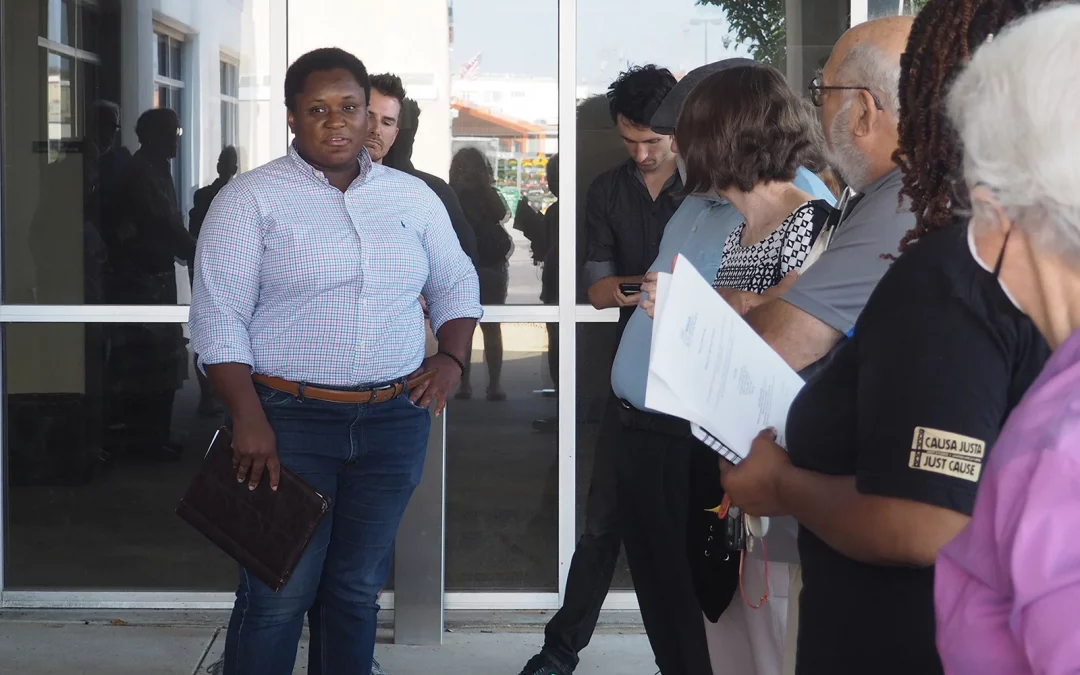
by Britny Cordera | Sep 19, 2022 | Commentary, Headline News, Social Justice |
(RNS) — A few weeks before speaking at a rally pushing for solutions to improve air quality in St. Louis, DeAndress Green was in the hospital, feeling like she was unable to breathe.
Green had suddenly begun feeling short of breath after spending some time in an industrialized north St. Louis neighborhood, where she was delivering food through DoorDash to families who lack transportation to grocery stores. When Green went to the hospital, doctors found blood clots in her lungs.
“I was in the hospital for a few days before the doctors figured out what was wrong,” she said at the July 23 rally, organized by Metropolitan Congregations United, a coalition of about 60 religious communities around St. Louis. Green works with MCU in its ongoing activism around local environmental crises. “That whole week, I lived in fear, planning for the worst.”
But for Green, a Black urban farmer and small business owner who had grown up in north St. Louis, this was but the latest in a lifetime of chronic respiratory problems — for her and for her family. All her family members suffer from asthma. She says she’s always known the cause: her neighborhood’s poor air quality.
Green grew up in the College Hill neighborhood, in government housing that was less than a mile from Procter & Gamble’s factory along the north St. Louis riverfront and other industrial facilities that burn metals or chemicals producing pollutants in the air. Trees were few and far between. The apartments in which she lived were plagued with black mold; the schools she attended had lead paint peeling from the walls. That’s also the case for many other members of the church she grew up in, Epiphany United Church of Christ, and other local congregations.
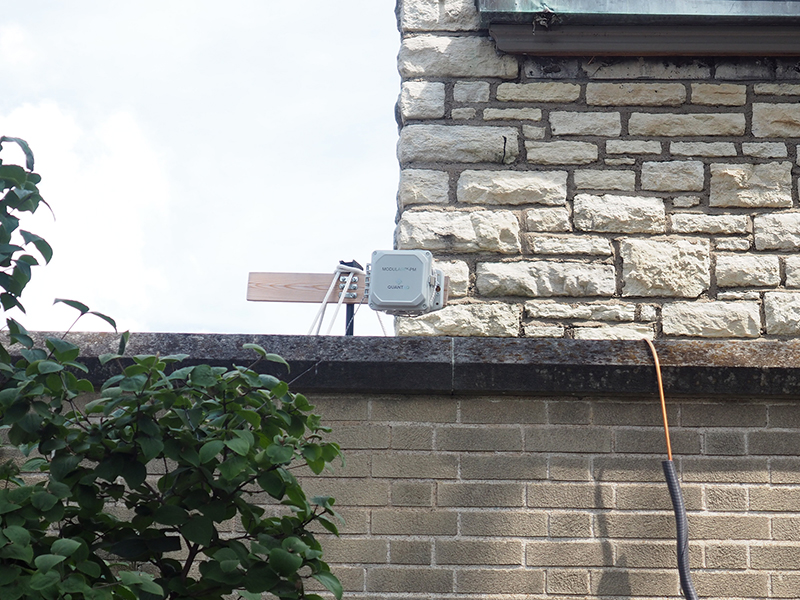
An example of one of the low-cost air pollution sensors at First Unitarian Church of St. Louis. Photo by Britny Cordera
Earlier this year, the multifaith coalition launched a new online air quality monitoring tool, tracking pollutants in the city in partnership with scientists at The Nature Conservancy; the Jay Turner Group, part of Washington University’s Department of Energy, Environmental and Chemical Engineering; and the university’s environmental studies program.
The community-based air quality monitoring initiative, AirWatch St. Louis, has been keeping track of what’s in the city’s air since December 2021. Low-cost sensors are placed on the roofs of MCU churches spread throughout the city to measure particulate matter, a mixture of solid particles and liquid droplets found in the air. Through the new digital map, the data collected by these sensors is publicly viewable.
MCU organizers say they see their efforts to collect and publish data on air quality as part of their spiritual commitment to racial and environmental justice. Since many religions believe that the Earth is sacred, created by a divine being, the effort to protect the environment brings congregations of varying backgrounds together to fight against climate change, according to Kentaro Kumanomido, an environmental justice organizer with United Congregations of the Metro East, another faith-based organization that worked closely with MCU on the air quality rally.
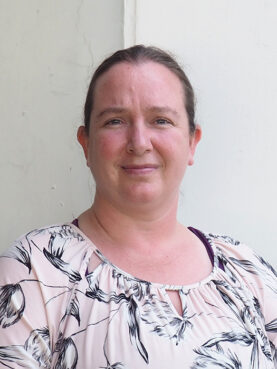
Beth Gutzler. Photo by Britny Cordera
Beth Gutzler, who has lived in houses with lead paint and currently lives near West Lake Landfill, where locals are concerned that trash smoldering underground is dangerously close to buried nuclear waste, leads MCU’s environmental justice team. She believes this project is critical to empower people in faith-based communities who are affected by industrial pollution, giving them the tools to take control of the fate of their neighborhoods through legislative action.
>“Our goal is to bring people of multiple faiths together to work towards a common goal of changing policy for social and environmental justice,” she says.
According to Tyler Cargill, a doctoral student with the Turner Group, the spatial variety and community connection MCU churches offer have been central to this project. Some of the churches are in downtown St. Louis, while others are in Webster Groves, a suburb. Some churches are in areas with a high density of roads. Some are near parks. And others are near industries that release particulate matter into the air.
“By having a variety of placements of these sensors, we do get to see if the urban planning of St. Louis makes any difference for what we’re seeing with our air pollution,” Cargill said.
A 2019 report on environmental racism in the city, published by the Washington University School of Law, found that most St. Louis’ air pollution sources are in predominantly Black neighborhoods.
According to the report, Black children in the city of St. Louis are 2.4 times more likely than white children to test positive for lead in their blood. They also account for more than 70% of children suffering from lead poisoning, researchers found, and make about 10 times more emergency room visits for asthma each year than white children. Majority-Black neighborhoods are more likely to be near highways and to see more building demolitions, which creates dust that may contain asbestos and lead.
“There are too few air pollution monitoring stations in St. Louis to allow for comparisons of air pollution in different neighborhoods,” the report noted. “However, the locations of air pollution sources, vehicle emissions, and demolitions all indicate that minority communities in St. Louis are being disproportionately exposed to harmful air pollution.”
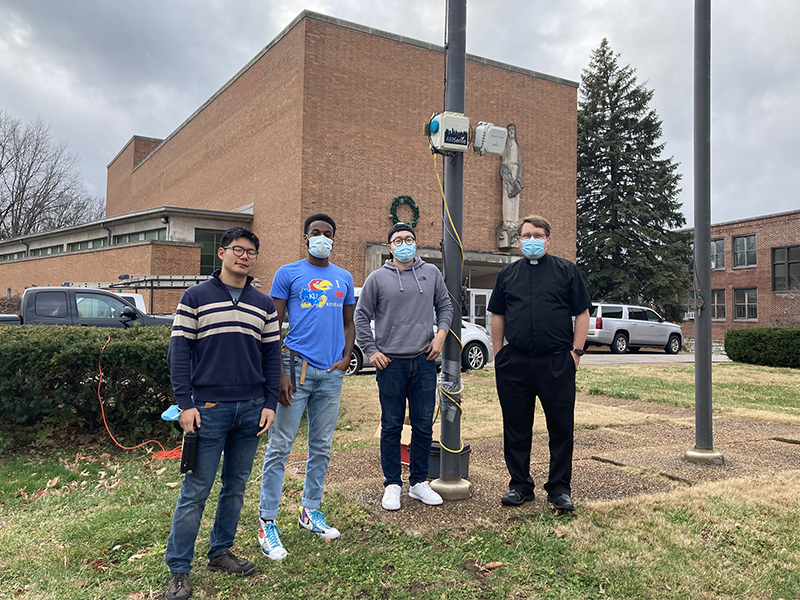
From left, David Yeom, intern with Washington University; Tyler Cargill, Washington University doctoral student with the Jay Turner Lab; and Li Zhiyao, also a doctoral student with the Jay Turner Lab, work with the Rev. Nick Winker to set up an air pollution monitor at St. Ann Catholic Church in St. Louis. Photo by Beth Gutzler
A national study published in 2019 found that people of color bear a disproportionate “pollution burden,” with Black Americans being exposed to 56% more pollutants in the air than they themselves create. This has deadly consequences: A study of nine deadly health conditions, including lung cancer, kidney disease and hypertension, linked with such exposure concluded that pollution kills about 200,000 Americans a year.
For MCU, working to improve air quality for vulnerable communities is a matter of faith.
The Rev. Kevin Anthony, who serves at Pilgrim Congregational United Church of Christ and as a member of MCU’s interfaith environmental justice task force, points to the biblical narrative of creation, in which God breathed “the breath of life” into man’s nostrils.
“I want us to imagine … each and every one of us having that same posture, leaning over one of our neighbors to breathe life into them,” he said during the rally. “In order for us to have life, we need to have good quality air to breathe.”
On Broadway, only a few blocks away from Green’s childhood home, neighborhoods are filled with abandoned buildings and illegal dumping. A sweet smell fills the air.
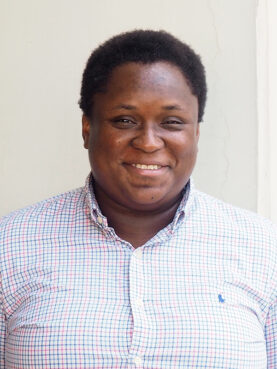
DeAndress Green. Photo by Britny Cordera
“I just assumed it was Hostess baking Twinkies, but the adults knew better,” she recalls. Her mother later told her the smell was an indication of industrial pollutants. “Broadway to the water is prime real estate for pollution industries.”
Whenever the sweet air filled the inside of the home, Green’s mother would take her and her siblings south to Tower Grove Park to get fresh air. “The difference in the environment in north St. Louis and south in St. Louis is unmistakable,” Green says. “There are trees, green spaces, businesses, and communities who want to be outside in south St. Louis.”
When Green moved out of government housing at 18, she was struck by how she could immediately breathe better.
Today, Green uses urban farming to heal her lungs and reconnect with the outdoors. But for many people of color in St. Louis and beyond, simply stepping outside is a potential health risk for environmental reasons. Families who live in so-called sacrifice zones, areas around the country where rates of cancer caused by air pollution exceed the U.S. definition of acceptable risk, are not being informed of the risks of industrial or Superfund sites — federally recognized hazardous waste sites — near their homes and are not given the resources to change their neighborhoods.
Community air quality monitoring programs, AirWatch St. Louis coordinators say, can arm those most affected with the knowledge to make informed decisions.
For Cargill, the project’s goal is to increase transparency. His lab gives periodic updates to the congregations and to the public. At these meetings, information is shared about air quality problems in general, what the Turner Group is doing with that research and what initiatives the community can take to advocate on its own behalf.
Action is even more urgent now that the White House’s Inflation Reduction Act gives $315.5 million for air monitoring so at-risk communities can be properly informed of what is in the air they breathe, offering an avenue toward legislation and reparations.
The particulate matter sensors on the church roofs, manufactured by QuantAQ, are a low-cost version of the EPA’s sensors, which cost tens of thousands of dollars. But even the monitors MCU is using cost $1,500.
Someday, Green would like to have her own air monitoring device. But even an at-home outdoor monitor from Purple Air costs nearly $300. She believes AirWatchSTL is helpful, but not everyone in her community has access to a smartphone or computer or has time to check the website to assess their risk.
“One of the things that I’d love to see happen is that maybe smaller devices are made available to communities,” says Green. “So we are allowed to see for ourselves how to navigate that environment.”
Organizers say solutions need to go beyond just making these sensors widely available. For Green, who was uninsured during her hospitalization and has been left with a pile of medical bills, real solutions must take the form of reparations.
That would look like Black families being allowed to dictate what will happen in their own communities, instead of nonprofits or think tanks coming in and implementing what they think will work, she says.
Green envisions a north St. Louis filled with trees, orchards, community gardens and native plants growing everywhere, cleaning the air she breathes.
“I want my community to feel like they can escape to north St. Louis and feel safe, not run from it because of racism and hate embedded in the land,” she says. “Solutions look like Black families being able to build their dreams in their front yards and provide food for their family from their own yard. Solutions look like families being able to breathe.”
This story was published in partnership with Next City, a nonprofit news organization covering solutions for just and equitable cities, as part of an ongoing series on how faith drives communities to work against urban injustices.
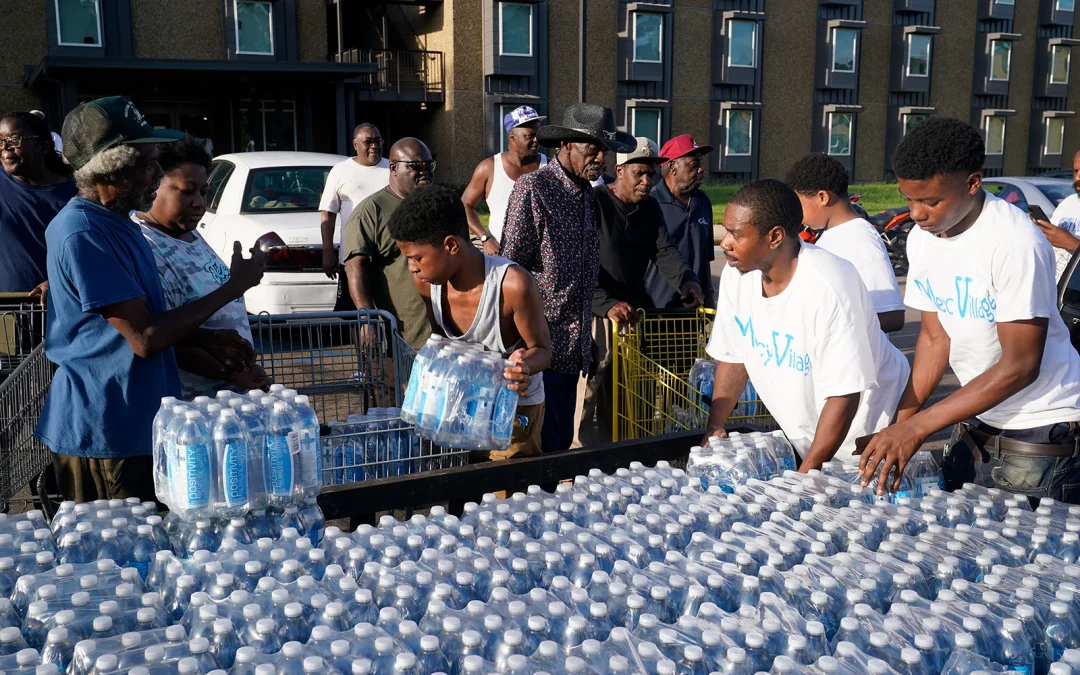
by Jemar Tisby | Sep 13, 2022 | Commentary, Headline News, Social Justice |
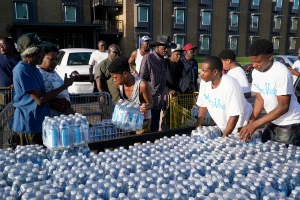
(RNS) — C.J. Rhodes, pastor of Mt. Helm Baptist Church in Jackson, Mississippi, was grabbing lunch from one of his regular spots when the restaurant manager made an announcement to all the patrons.
“Guys, we have to shut down. We have no water pressure.”
On Aug. 29, flooding from the nearby Pearl River caused complications at the O.B. Curtis Water Plant, resulting in a loss of pressure and running water for the entire city.
At more than 160,000 people, Jackson is Mississippi’s largest city and the state capital. Schools, which had only just commenced classes, had to be shut down, and the city lacked water for even emergency services such as firefighting.
The crisis quickly made national news, and people from around the country turned their attention to Jackson seeking explanations and ways to help.
Within the city, residents quickly organized to help their neighbors and communities. At the center of these efforts stood faith leaders.
“Churches throughout the city of Jackson across denomination, class and race have engaged in water distributions at their churches or by giving water away in other ways,” said Rhodes.
His church became a water distribution site. As provisions flooded into the city from around the country, churches like his became hubs for supplying residents. Sometimes churches filled in where municipal distribution efforts were limited. They could stay open after hours to serve people who couldn’t make it to the city’s distribution sites before closing.
Jennifer Biard, lead pastor of Jackson Revival Center Church, lost water several days before the city-wide announcement. She came home and found the faucets simply didn’t work.
While dealing with her own water troubles, she led her church in providing for others in the southern part of the city where they have a campus. Throughout the crisis many water distribution sites were set up at various locations, but Biard and her volunteers went even further. They loaded up cases of water and hand-delivered them to individuals and businesses.
“One thing people don’t understand is that when you have people who are disabled, people who are without transportation, they may not be able to go out to the distribution sites,” she explained.
Individual churches were not the only bodies that got involved.
Reginald M. Buckley is the pastor of Cade Chapel Missionary Baptist Church. He is also the president of the General Missionary Baptist State Convention of Mississippi (GMBSC), an association of churches providing mutual aid to member congregations.
“There’s only so much any local church can do … (the convention) acts as a connector,” Buckley said.
His goal was to mobilize people and supplies from across the state and nation to help people in Jackson. The state convention has its own 18-wheel truck as well as an extensive network of churches and personnel they contacted to help.
“Though this is a trying time, one of the things that I am most grateful for is the unity that people are able to observe, how they are seeing pastors and churches come together regardless of race, regardless of denomination, regardless of anything that would divide. They are seeing the body of Christ come together like never before,” Buckley said.
Despite the efforts of churches and faith communities to provide relief, the water problems in Jackson are much deeper than a breakdown at the water plant.
The city had already been under a boil water notice for a month before the entire water system failed. Even after the city’s water pressure was restored nearly a week later, the boil water notice has remained in effect.
Although the water plant has come back online, the infrastructure issues remain.
“Now that the plant is up and running, water is flowing again, now we have to live with pipes bursting … We still have lead leaching from the pipes into the water. We still have the EPA saying the city has failed to do a number of things and if they don’t remedy those things, there may be federal seizure of the water system,” Rhodes said.
Given the continued failure to bring Jackson’s water infrastructure system up to date, Buckley said he is preparing for the next crisis.
“What we’re absolutely convinced of is that we’re going to be faced with this again, and not in the distant future but in the near future,” he said.
Buckley is working to build a stockpile of supplies to have on hand the next time the city loses water. “We are inundated with water right now. We are partnering with the Church of Christ Holiness to create a reserve and supplies center to house water, buckets and all kinds of supplies,” he said.
The constant lack of clean water and water pressure has worn on Jackson’s residents, 80% of whom are Black.
“We should have water,” Biard, who is white, said. “We should have water whether it’s cold or hot or snowing or raining.”
Jackson exists alongside wealthier suburbs including Madison, a community north of the city that is also the wealthiest in the state.
After years of experiencing a crumbling infrastructure alongside the comparative wealth of nearby towns, a freshman college student who is Black asked Buckley, “What’s wrong with me?”
“We assured her there was nothing wrong with her. There is something wrong with the world,” said Buckley, who tried to help his young parishioner understand that the fault did not rest with who she was but with external factors and decisions made by others.
Anticipating the need not only for material supplies but spiritual relief, award-winning gospel artist John P. Kee volunteered to perform a benefit concert in Jackson.
A friend of Kee’s in Jackson connected him to Biard, and he immediately knew she was someone who could help him set up the concert but also become an ongoing partner.
“I wanted to come in and partner with such a ministry where we could actually connect, and when I’m gone I’ll stay in touch, and I’ll be family,” Kee said.
Fixing Jackson’s pipes, water plant and other infrastructure needs requires resources that exceed what local churches can provide. Yet the lightning-quick response of faith leaders and their communities when the hour of need emerged provides evidence that help will be there in a crisis.
The show of unity by churches in Jackson may even be a sign of greater changes to come.
According to Biard, “I believe that this may be not just the initiation of a fresh start for Jackson, I believe it’s going to be a comprehensive fresh start … I believe that the Lord is getting ready to do something for Mississippi as a whole.”
To support local efforts to address the water crisis in Jackson, donate below.
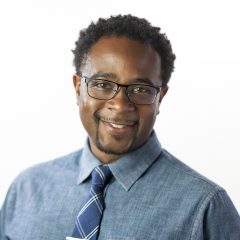
Jemar Tisby. Photo courtesy Acorn Studio
General Missionary Baptist State Convention of Mississippi
Corporation of Global Community, a ministry of Jackson Revival Center Church.
(Jemar Tisby, PhD, is a historian, author and speaker. He wrote “The Color of Compromise” and “How to Fight Racism,” and he frequently writes about race, religion and politics in his newsletter, “Footnotes.” The views expressed in this commentary do not necessarily reflect those of Religion News Service.)
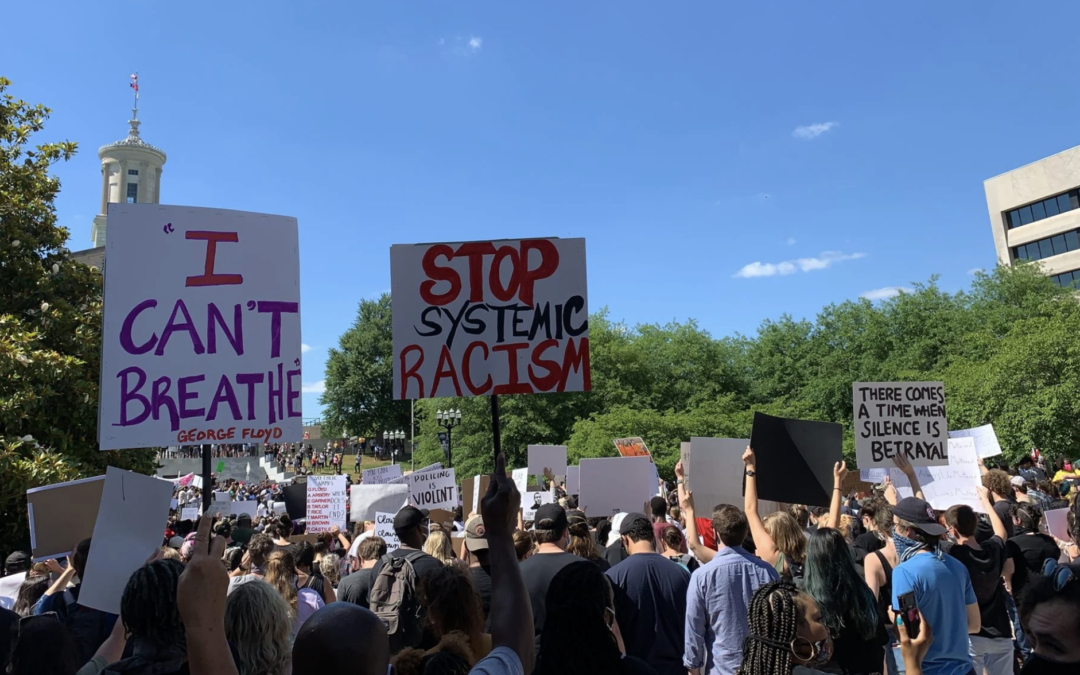
by Maina Mwaura, Urban Faith Contributing Writer | Jul 13, 2022 | Commentary, Headline News, Social Justice |
The unjust killings of African Americans at the hands of law enforcement over the past several years have become all too common news. But New York Times bestselling author Marc Lamont Hill and his co-author Todd Brewster masterfully weave together the strands of social justice uprisings, technology, and social media to talk about how the deaths of black people by police led to viral and physical social justice movements that have reshaped our national discourse.
UrbanFaith contributor Maina Mwaura spent a few moments with Marc Lamont Hill to discuss his the new book Seen & Unseen: Technology, Social Media & the Fight For Racial Justice. The full interview is above. More about the book is below.
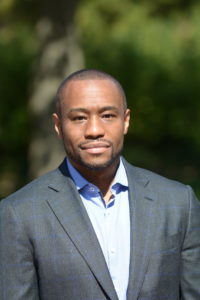 With his signature “clear and courageous” (Cornel West) voice Marc Lamont Hill and New York Times bestselling author Todd Brewster weave four recent pivotal moments in America’s racial divide into their disturbing historical context—starting with the killing of George Floyd—Seen and Unseen reveals the connections between our current news headlines and social media feeds and the country’s long struggle against racism.
With his signature “clear and courageous” (Cornel West) voice Marc Lamont Hill and New York Times bestselling author Todd Brewster weave four recent pivotal moments in America’s racial divide into their disturbing historical context—starting with the killing of George Floyd—Seen and Unseen reveals the connections between our current news headlines and social media feeds and the country’s long struggle against racism.
For most of American history, our media has reinforced and promoted racism. But with the immediacy of modern technology—the ubiquity of smartphones, social media, and the internet—that long history is now in flux. From the teenager who caught George Floyd’s killing on camera to the citizens who held prosecutors accountable for properly investigating the killing of Ahmaud Arbery, ordinary people are now able to reveal injustice in a more immediate way. As broad movements to overhaul policing, housing, and schooling gain new vitality, Seen and Unseen demonstrates that change starts with the raw evidence of those recording history on the front lines.
In the vein of The New Jim Crow and Caste, Seen and Unseen incisively explores what connects our moment to the history of race in America but also what makes today different from the civil rights movements of the past and what it will ultimately take to push social justice forward.
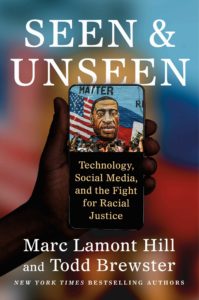
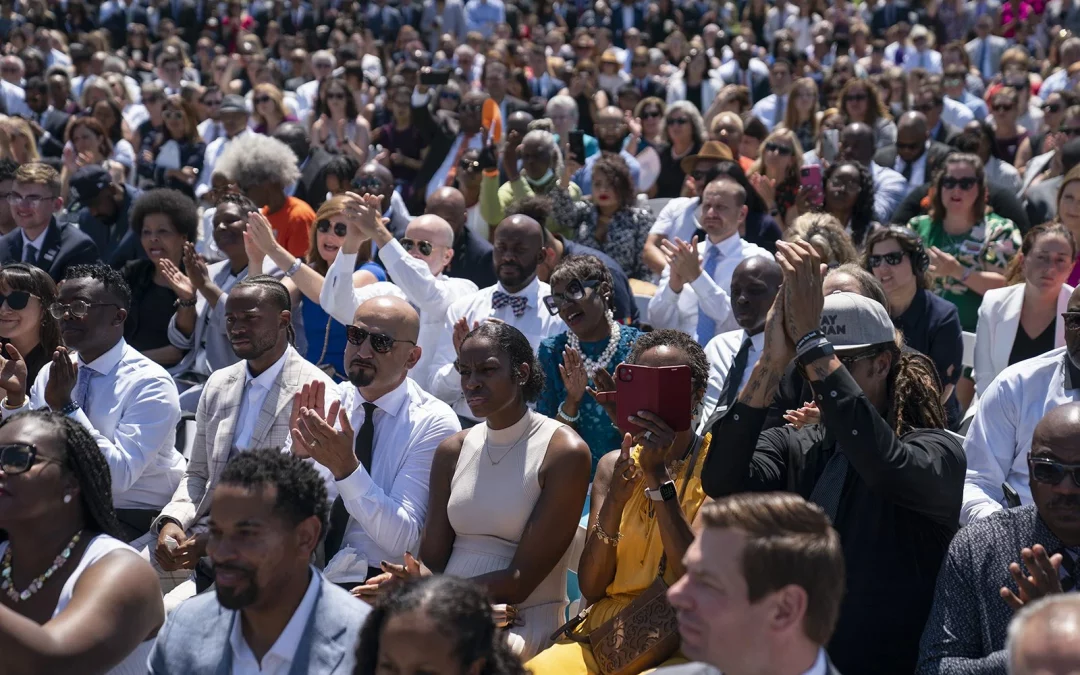
by Adelle M. Banks and Jack Jenkins, RNS | Jul 12, 2022 | Headline News, Social Justice |
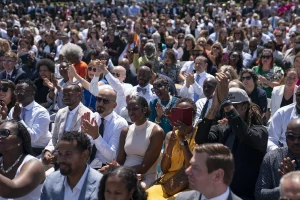
(RNS) — Faith leaders from a wide range of traditions, including those whose houses of worship have been attacked, were at the White House Monday (July 11) as members of Congress and other gun control advocates gathered for a White House celebration of the Bipartisan Safer Communities Act, signed into law June 25.
Pastor Mike McBride, the leader of Live Free USA, who has long sought political support to especially help the nation’s urban centers, hailed the signing as an opportunity to address gun violence deaths that do not always make national headlines.
“It’s been a very difficult task to get the death of Black men in this country, much less the death of any Black folks, to receive national attention and intervention,” said McBride. “Even among Democrats — Democrats have not been the most political champions for this work. So it’s taken us 10 years to get to $250 million committed in a bipartisan way.”
On hand were Rabbi Jonathan Perlman and others who endured a mass shooting in 2018 at the Tree of Life Synagogue in Pittsburgh and the Rev. Sharon Risher, whose mother was among the nine African American worshippers killed during the 2015 shooting at Mother Emanuel AME church in Charleston, South Carolina.
“That was beautiful — to see all these heroic people, survivors that have been working for change,” said Shane Claiborne, co-founder of the group Red Letter Christians and leader of an effort that melts down guns into garden tools in observance of the biblical call to turn “swords into plowshares.”
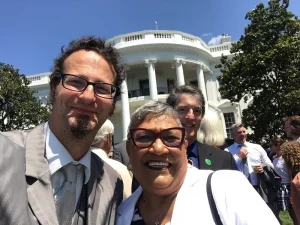 But Claiborne added that he understood that the bipartisan legislation “is the most substantial gun reform bill that we’ve seen in 30 years. But what we also heard is how dysfunctional our political process is — because there’s so much more that’s needed.”
But Claiborne added that he understood that the bipartisan legislation “is the most substantial gun reform bill that we’ve seen in 30 years. But what we also heard is how dysfunctional our political process is — because there’s so much more that’s needed.”
“We need a ban on assault rifles,” he added.
The legislation includes a variety of interventions into gun purchasing, including expansion of background checks for people younger than 21, $250 million for community-based violence prevention initiatives and $500 million to increase the number of mental health staffers in school districts.
President Joe Biden, in remarks from the White House’s South Lawn, decried the violence that has turned houses of worship, schools, nightclubs and stores into places of death.
“Neighborhoods and streets have been turned into killing fields as well,” said the president. “Will we match thoughts and prayers with action? I say yes. And that’s what we’re doing here today.”
Claiborne said he presented a Christian cross made from a melted-down gun barrel to second gentleman Douglas Emhoff, as well as to a friend of President Biden.
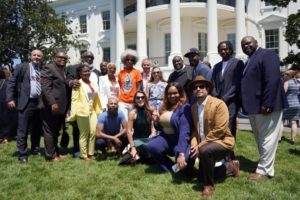 McBride said his efforts with faith leaders on this issue date back to a 2013 meeting at the Obama White House, when Biden was vice president.
McBride said his efforts with faith leaders on this issue date back to a 2013 meeting at the Obama White House, when Biden was vice president.
“In 2013, we asked for $300 million, and we were told no,” he recalled. “And so some 10 years later, we’ve gotten close to that original ask.”
He said the programs for which groups like the Fund Peace Foundation seek support are “targeted for Black and brown communities that are dealing with the highest rates of gun violence,” including from gangs and intimate partners.
Other faith groups have responded to the passage of the legislation with statements of support.
“The investments in mental health services and reasonable measures to regulate guns included in this bill are positive initial steps towards confronting a culture of violence,” said Archbishop Paul S. Coakley of Oklahoma City, chairman of the U.S. Conference of Catholic Bishops’ Committee on Domestic Justice and Human Development.
“We are heartened that after almost three decades of gridlock, Congress has finally taken bipartisan action to address America’s gun violence epidemic and end violent crime,” said Melanie Roth Gorelick, senior vice president of the Jewish Council for Public Affairs. “This is a huge victory, but we cannot allow this to be the end.”
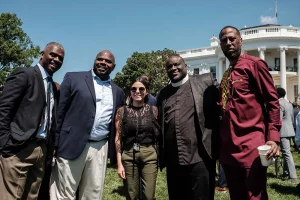 While calling himself grateful for this historic development, McBride said he and his partners will be pushing for far more support.
While calling himself grateful for this historic development, McBride said he and his partners will be pushing for far more support.
“This will be a failure if this is the only thing they do for the next few years,” he said.
Biden seemed to agree that further action was needed.
“We have so much more work to do,” he concluded. “May God bless all of us with the strength to finish the work left undone, and on behalf of the lives we’ve lost and the lives we can save, may God bless you all.”
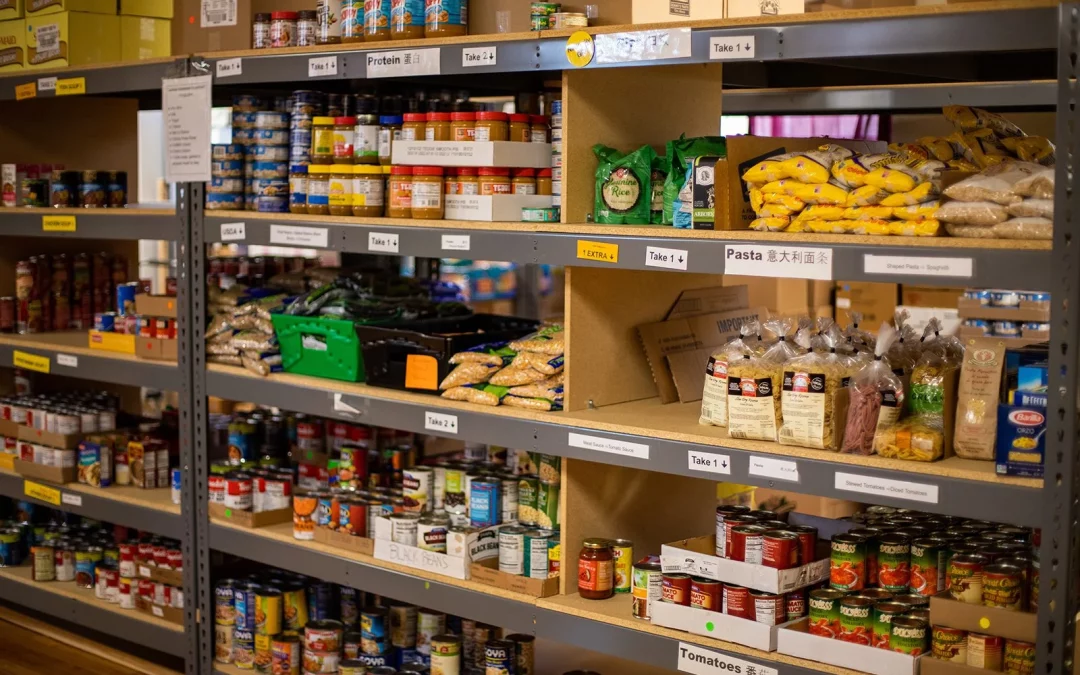
by Haley Barker, Riley Farrell, and Marika Proctor (RNS) | Jul 7, 2022 | Commentary, Headline News, Social Justice |
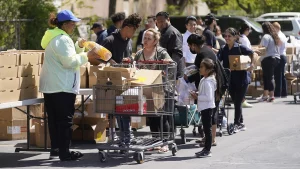
(RNS) — At the Seven Loaves Food Pantry at St. Andrew’s United Methodist Church in Plano, Texas, volunteers have been serving 800 to 1,200 families a week since the COVID-19 pandemic began — about four times the weekly traffic in 2019.
At the ICNA Relief Food Pantry in Raytown, Missouri, just east of Kansas City, 100 new families have registered to receive the Muslim-led organization’s services in just the past month.
“We are busier than ever right now,” said Shannon Cameron, executive director of the Aurora Area Interfaith Food Pantry in Aurora, Illinois, where, after a slight dip around tax return season, between 30 and 60 new families are registering every week.
The inflation that has loomed over the economy and restricted many Americans’ purchasing power of late has doubly affected low-income people who already struggle to get by. A recent survey by the anti-hunger organization Feeding America has shown that increased demand has affected nearly 80% of U.S. food banks, as higher prices cause more families to seek assistance.
And while President Joe Biden recently signed the Keep Kids Fed Act, extending free meal programs for schoolchildren, many stopgaps funded during the pandemic have ended or are only available in some states.
“For the households that were already food insecure in 2020, nearly half of those reported using a food pantry,” said Jordan Teague, interim director for policy analysis and coalition building at Bread for the World. “Now, more people are facing the crisis. We’re all sort of feeling that pinch, and government programs are coming to an end.”
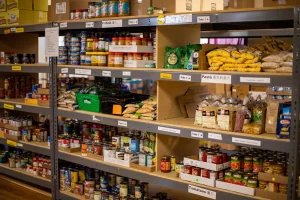
Since the 1980s, the U.S. Department of Agriculture has donated surplus commodities it buys to stabilize farm prices to the Charitable Food Assistance System, a network of food banks. For four years, the Trump administration bolstered the program to offset the cost of its tariff increases, raising the share of the USDA’s contributions to as much as 15% of some food banks’ supplies. Those resources, too, have now tailed off.
“We saw a real increase even before the pandemic hit in those USDA commodities and, obviously, during the pandemic, USDA made more commodities available as well,” said Celia Cole, CEO of Feeding Texas, a faith-based food security organization based in Austin. “Now, without them, we’re seeing a drop-off.”
Food banks are looking more than ever to make up the gaps with private monetary donations, and government financial assistance. “For every dollar donated to a food bank, we can stretch it to four meals,” said Cole. “We encourage people to be educated with their elected officials in support of hunger-fighting programs like SNAP and the Child Nutrition Programs.”
Historically high gas prices have added further strain on local food pantries, causing delays in the transport of food from farm to market, and from market to food banks.
“We own a fleet of semis,” said Mike Hoffman, inventory and logistics director at Midwest Food Bank, a Christian charity that supplies more than 2,000 churches, nonprofits and community centers across the country. “Fuel prices have taken a toll. We’ve gone through our entire year’s fuel budget in the first five months.”
The same supply chain problems, including a lack of available truck drivers, that have beset the economy apply to fighting hunger as well. Barbara Wojtklewicz, part of the leadership team that runs the food pantry at Christ Church in Plymouth, Massachusetts, said staff at the Greater Boston Food Bank, a regional network of 600 food distributors, have reported driver shortages recently.
“There is ample food to distribute,” Wojtklewicz told Religion News Service, “but they’ve had to limit … distribution to different food pantries.”
Maj. Deb Coolidge at the Salvation Army’s food distribution center in Plymouth has had trouble sourcing fresh food. “Less salad mix and cucumber — oranges and apples,” Coolidge said. “Those have not been on the list for the last couple of months.”
At ICNA Relief in Missouri, Ferdous Hossain, associate operations coordinator, has likewise found it increasingly difficult to provide fresh produce to the 300 families who rely on the pantry for food assistance each month. Local agencies, farms and food banks that ICNA collaborates with are also feeling the produce pinch.
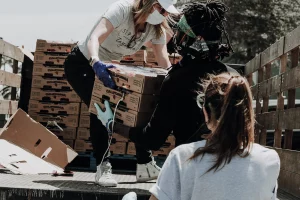 To live up to her center’s unofficial motto — “Fresh produce. Fresh fruit. Anything and everything that is fresh” — Hossain has been buying produce at the grocery store, a last resort because of higher prices.
To live up to her center’s unofficial motto — “Fresh produce. Fresh fruit. Anything and everything that is fresh” — Hossain has been buying produce at the grocery store, a last resort because of higher prices.
Donors are also stepping up, thinking creatively to help fill the gaps. Wojtklewicz said that the Christ Church pantry in Plymouth received 100 gift cards to local grocery stores along with its shipment from the Greater Boston Food Bank.
As economists prepare Americans for a possible recession, Beth Zarate, president and CEO of Catholic Charities West Virginia, expressed “anxiety” about the rural residents in her state and their ability to stay ahead of increased gas prices and food costs. At 15.1%, West Virginia has the highest percentage of households facing hunger, according to a 2020 USDA study.
Zarate is counting on West Virginians to come to their neighbors’ aid. “West Virginia is unique because we come out at the bottom of every chart in terms of chronic health issues, hunger and poverty,” Zarate said. “But we also have people who are good to each other.”
“People are generous,” said Darra Slagle, director of Rose’s Bounty, a food pantry operating out of Stratford Street United Church in Boston, “and when they are made aware of the need, are able to help. I encourage people to give to their local food pantries. They could use money to get the things that they need.”
Hoffman at the Midwest Food Bank said prayer is another life raft for anti-hunger operations.
“We have a lot of prayer warriors,” he said. “The faith community is a huge part of what we do, (and) many churches pray for us. The Bible says, ‘The poor you’ll have with you always,’ so we know we have a job that needs to be done, and we’ll keep getting it done.”












 With his signature “clear and courageous” (Cornel West) voice Marc Lamont Hill and New York Times bestselling author Todd Brewster weave four recent pivotal moments in America’s racial divide into their disturbing historical context—starting with the killing of George Floyd—Seen and Unseen reveals the connections between our current news headlines and social media feeds and the country’s long struggle against racism.
With his signature “clear and courageous” (Cornel West) voice Marc Lamont Hill and New York Times bestselling author Todd Brewster weave four recent pivotal moments in America’s racial divide into their disturbing historical context—starting with the killing of George Floyd—Seen and Unseen reveals the connections between our current news headlines and social media feeds and the country’s long struggle against racism.


 But Claiborne added that he understood that the bipartisan legislation “is the most substantial gun reform bill that we’ve seen in 30 years. But what we also heard is how dysfunctional our political process is — because there’s so much more that’s needed.”
But Claiborne added that he understood that the bipartisan legislation “is the most substantial gun reform bill that we’ve seen in 30 years. But what we also heard is how dysfunctional our political process is — because there’s so much more that’s needed.” McBride said his efforts with faith leaders on this issue date back to a 2013 meeting at the Obama White House, when Biden was vice president.
McBride said his efforts with faith leaders on this issue date back to a 2013 meeting at the Obama White House, when Biden was vice president. While calling himself grateful for this historic development, McBride said he and his partners will be pushing for far more support.
While calling himself grateful for this historic development, McBride said he and his partners will be pushing for far more support.


 To live up to her center’s unofficial motto — “Fresh produce. Fresh fruit. Anything and everything that is fresh” — Hossain has been buying produce at the grocery store, a last resort because of higher prices.
To live up to her center’s unofficial motto — “Fresh produce. Fresh fruit. Anything and everything that is fresh” — Hossain has been buying produce at the grocery store, a last resort because of higher prices.